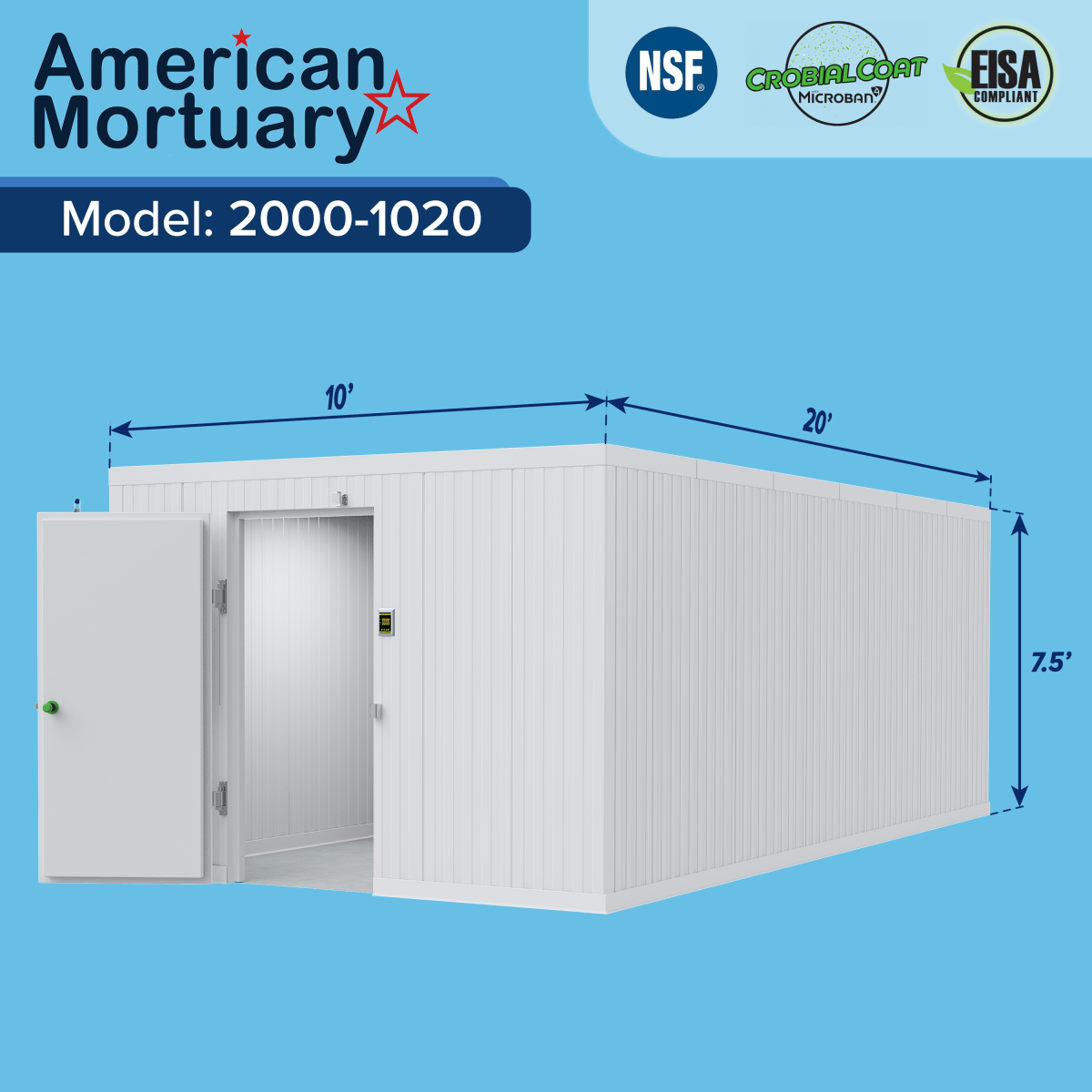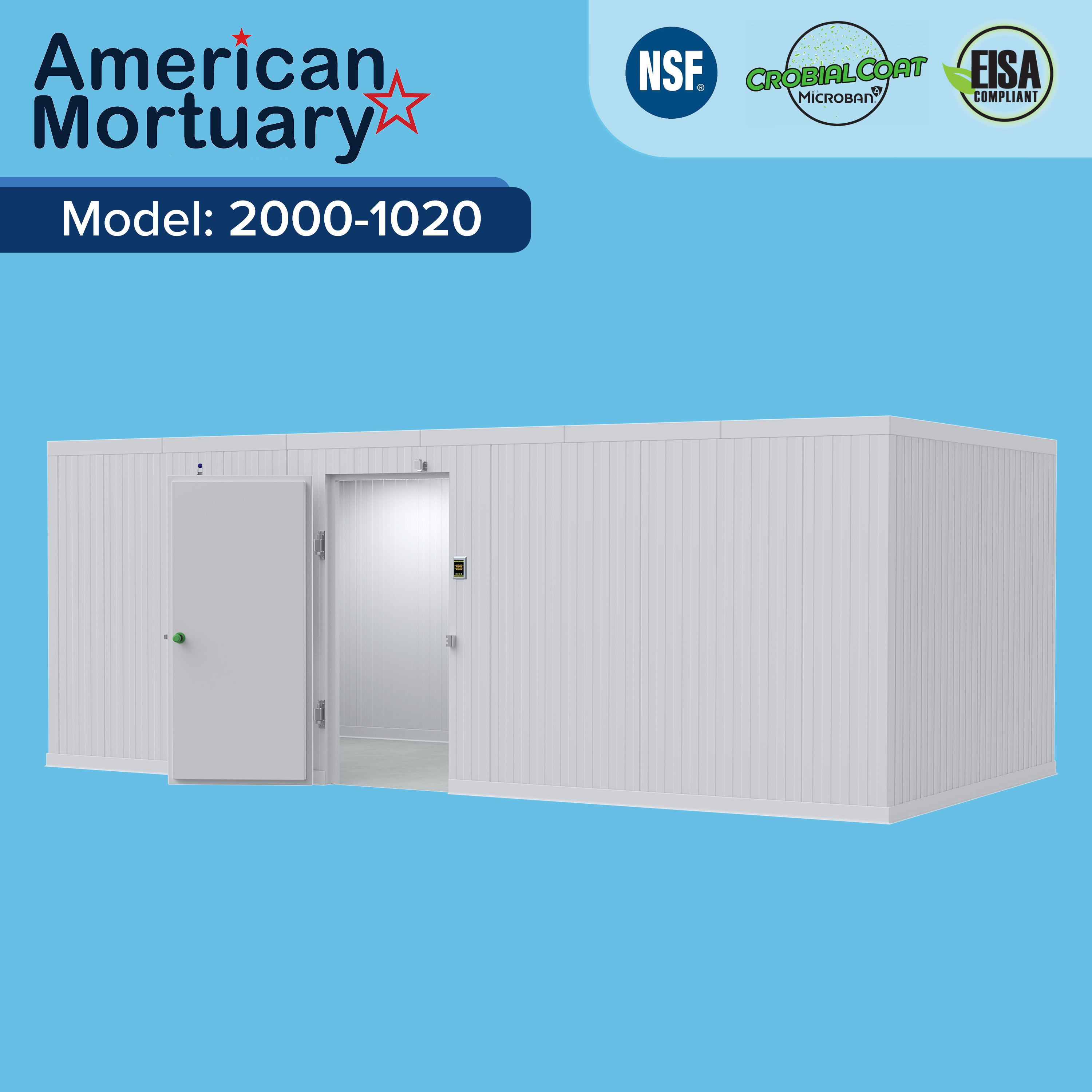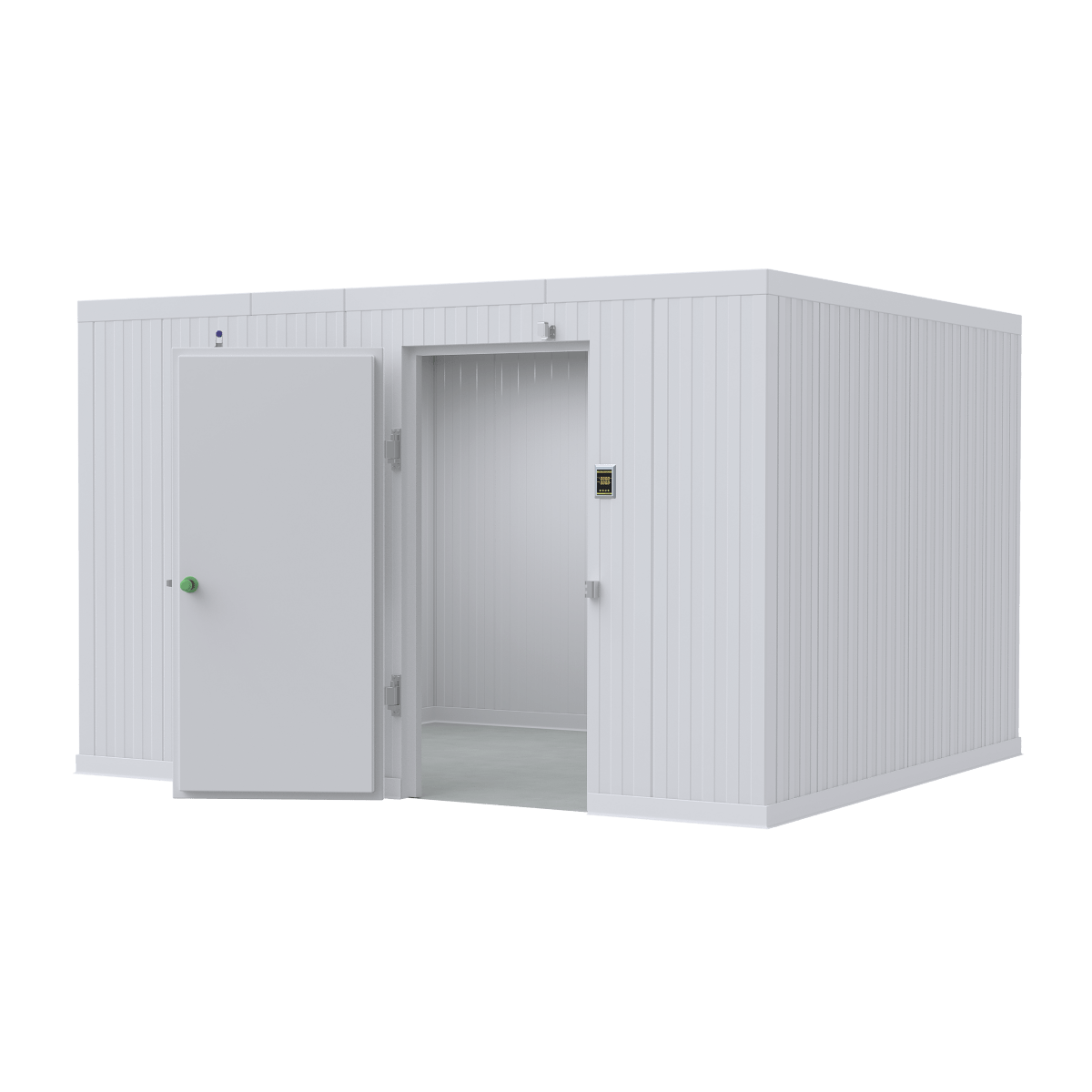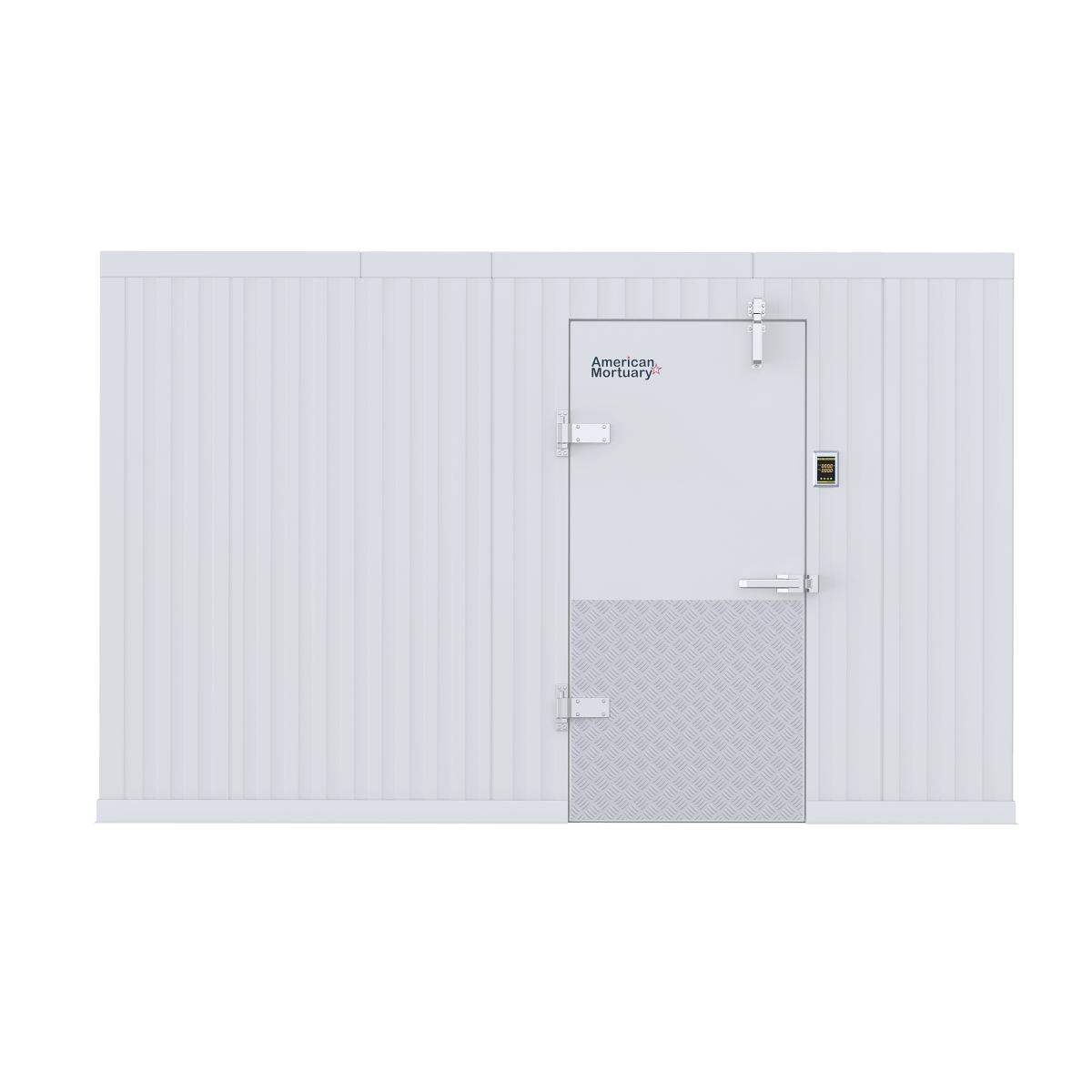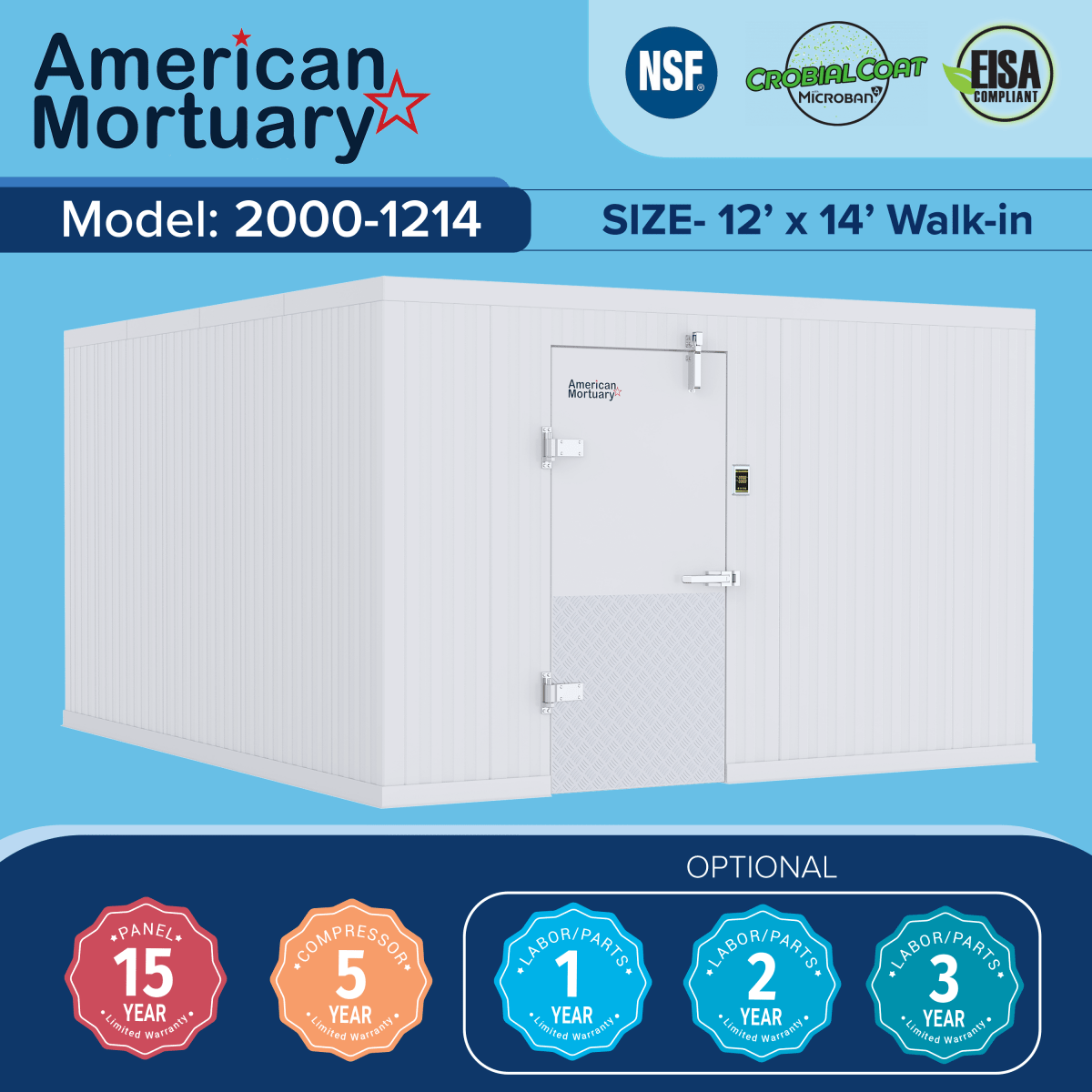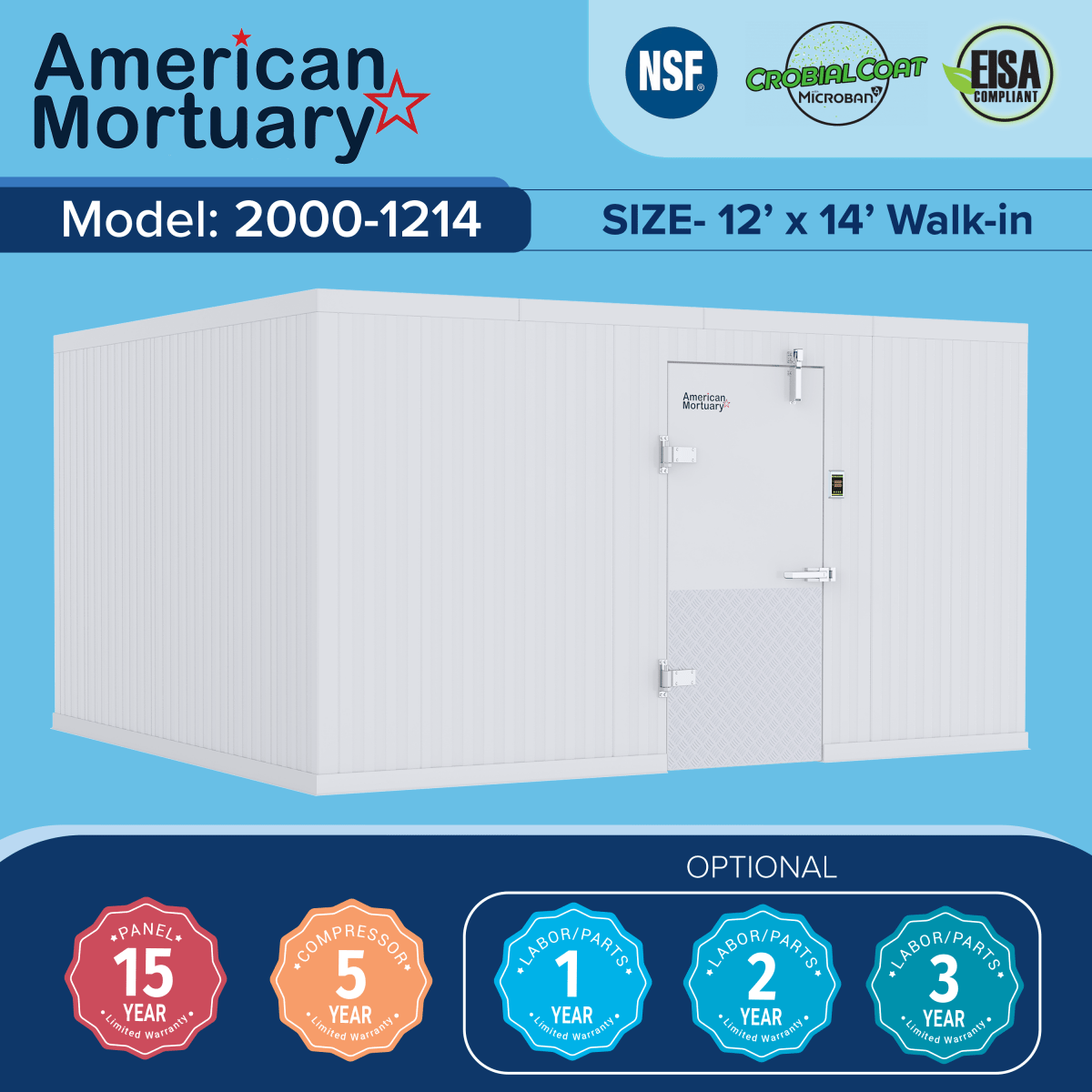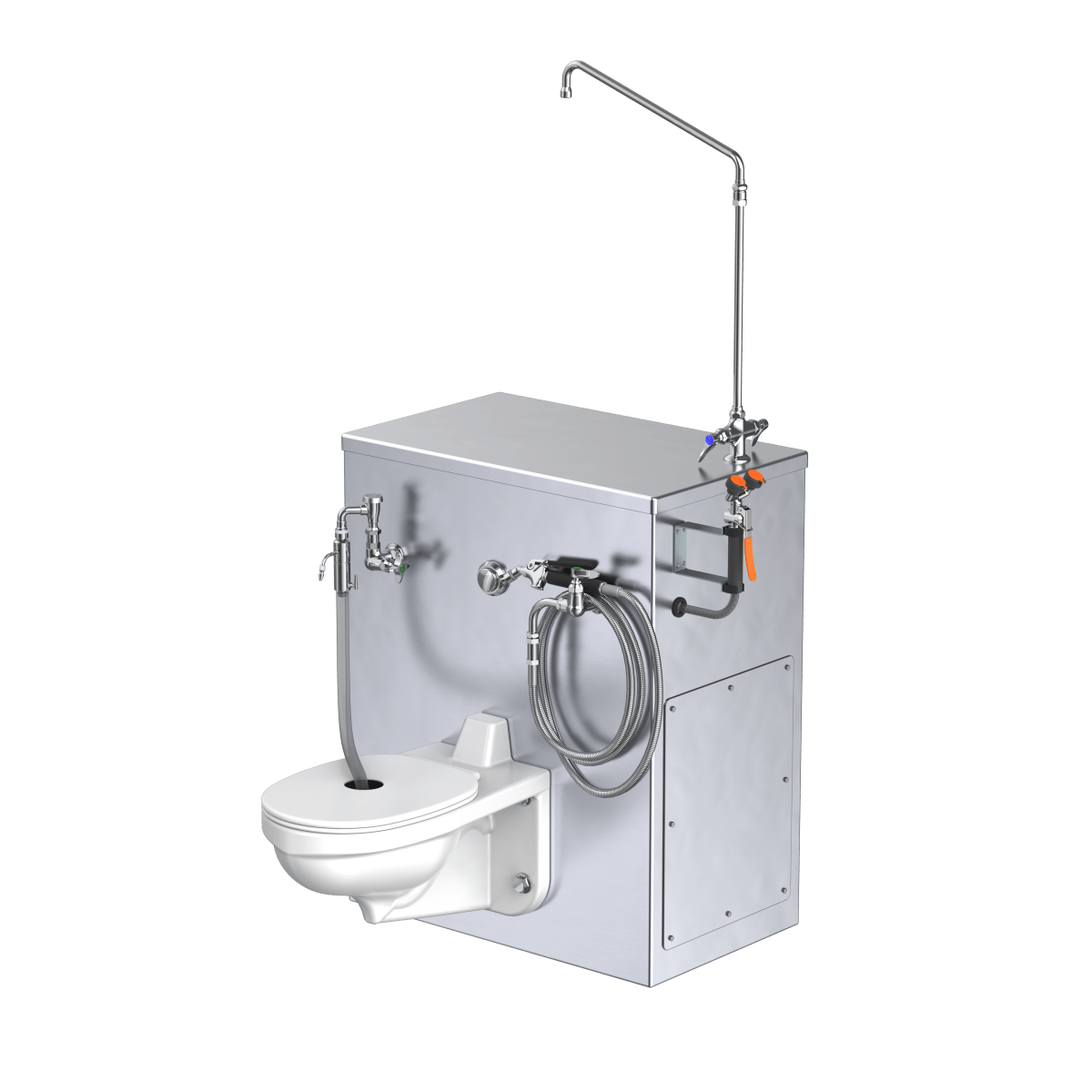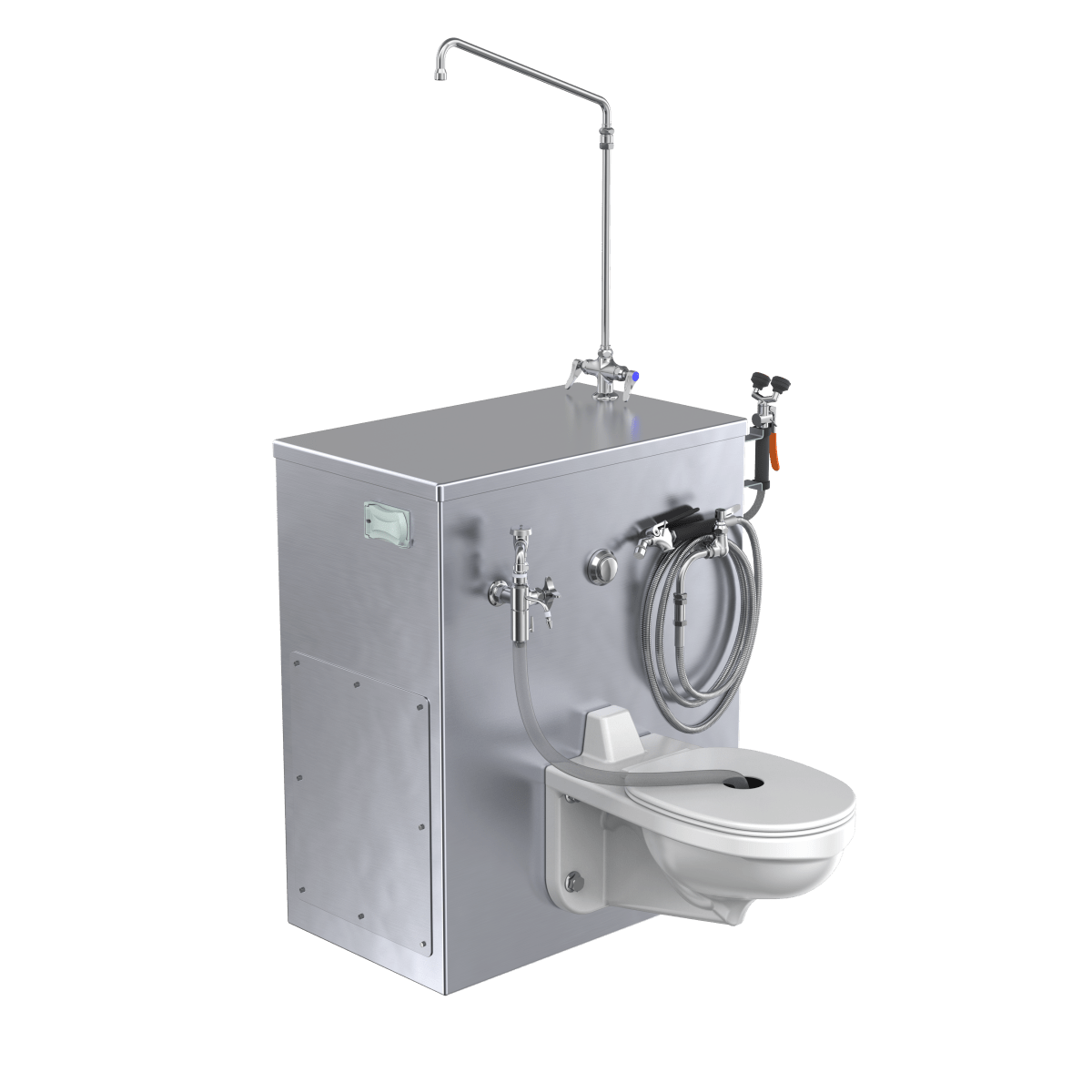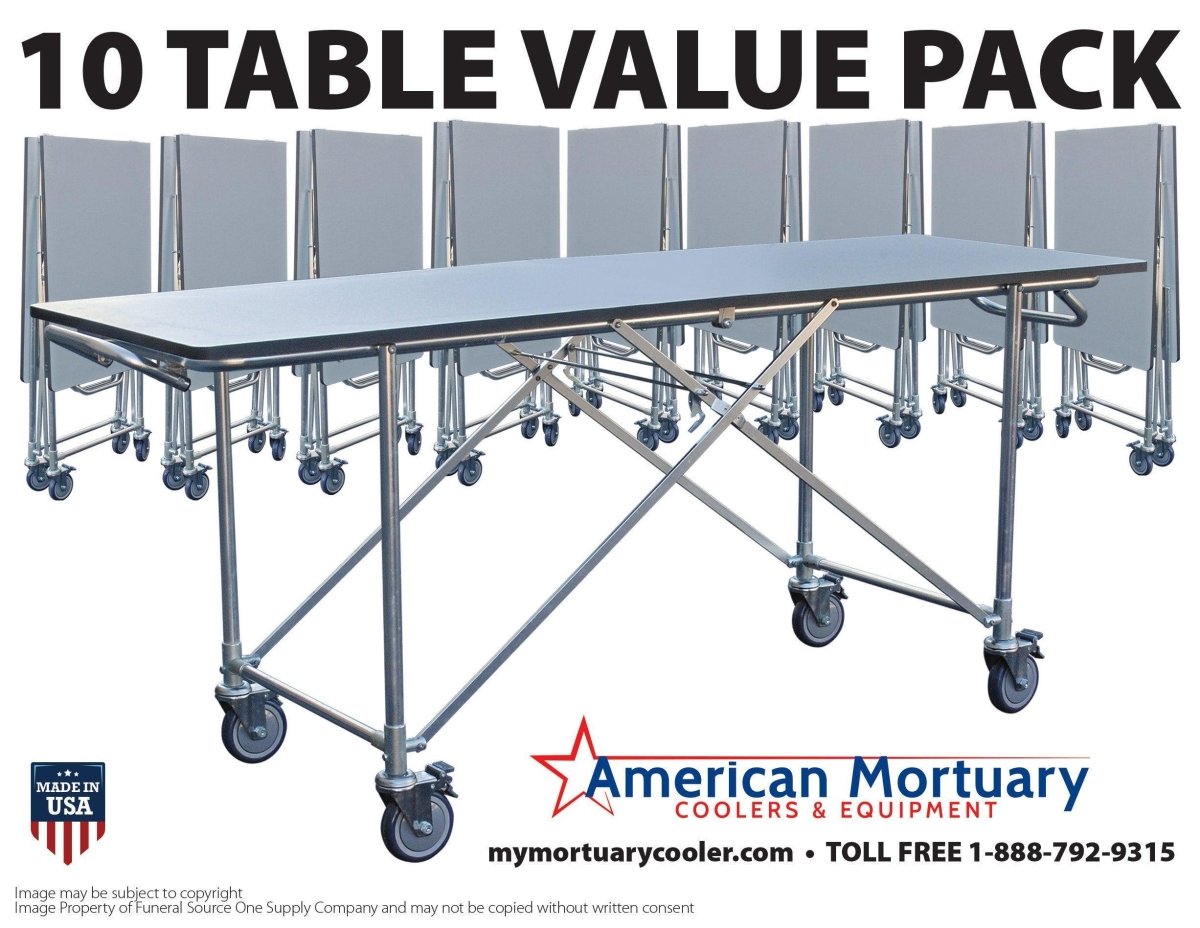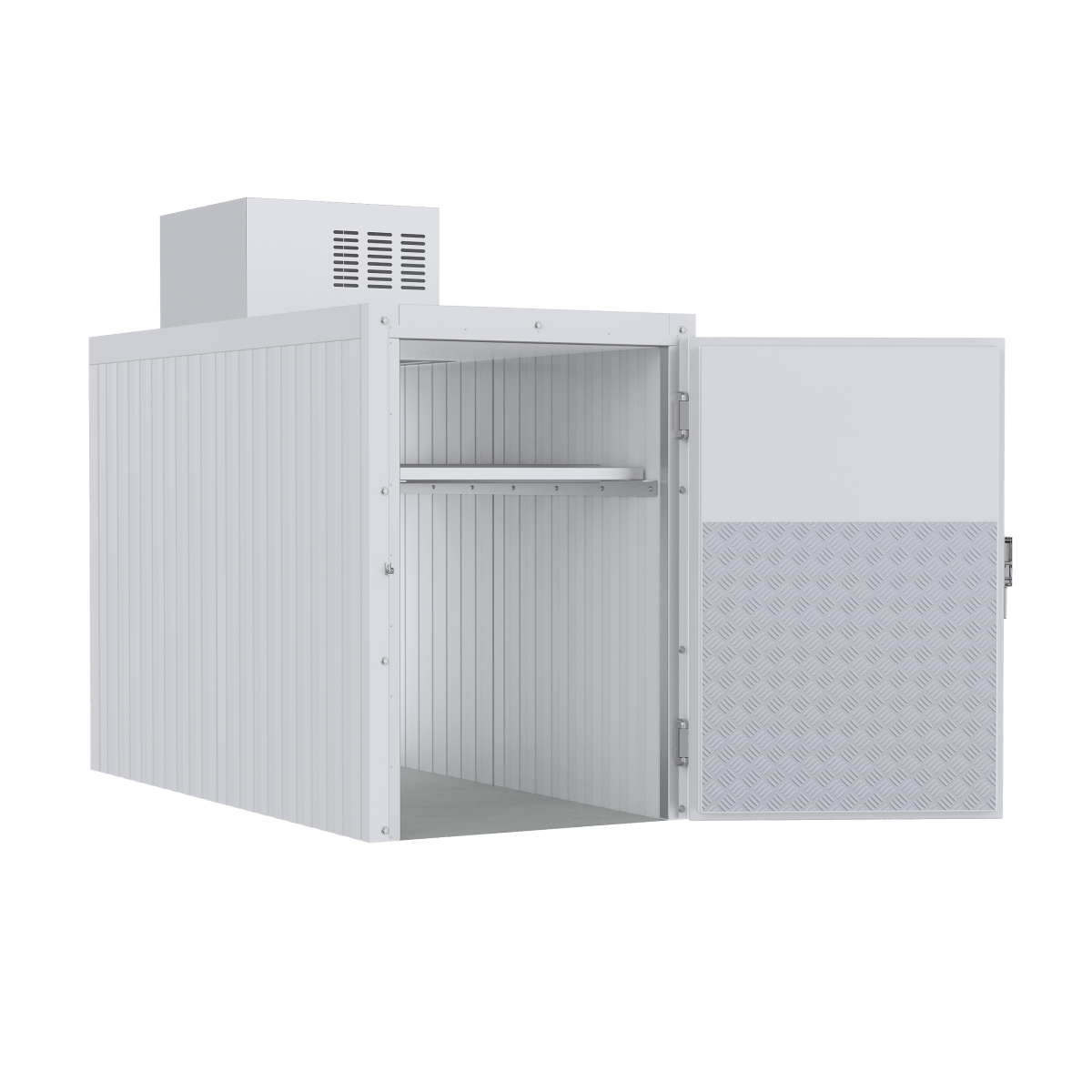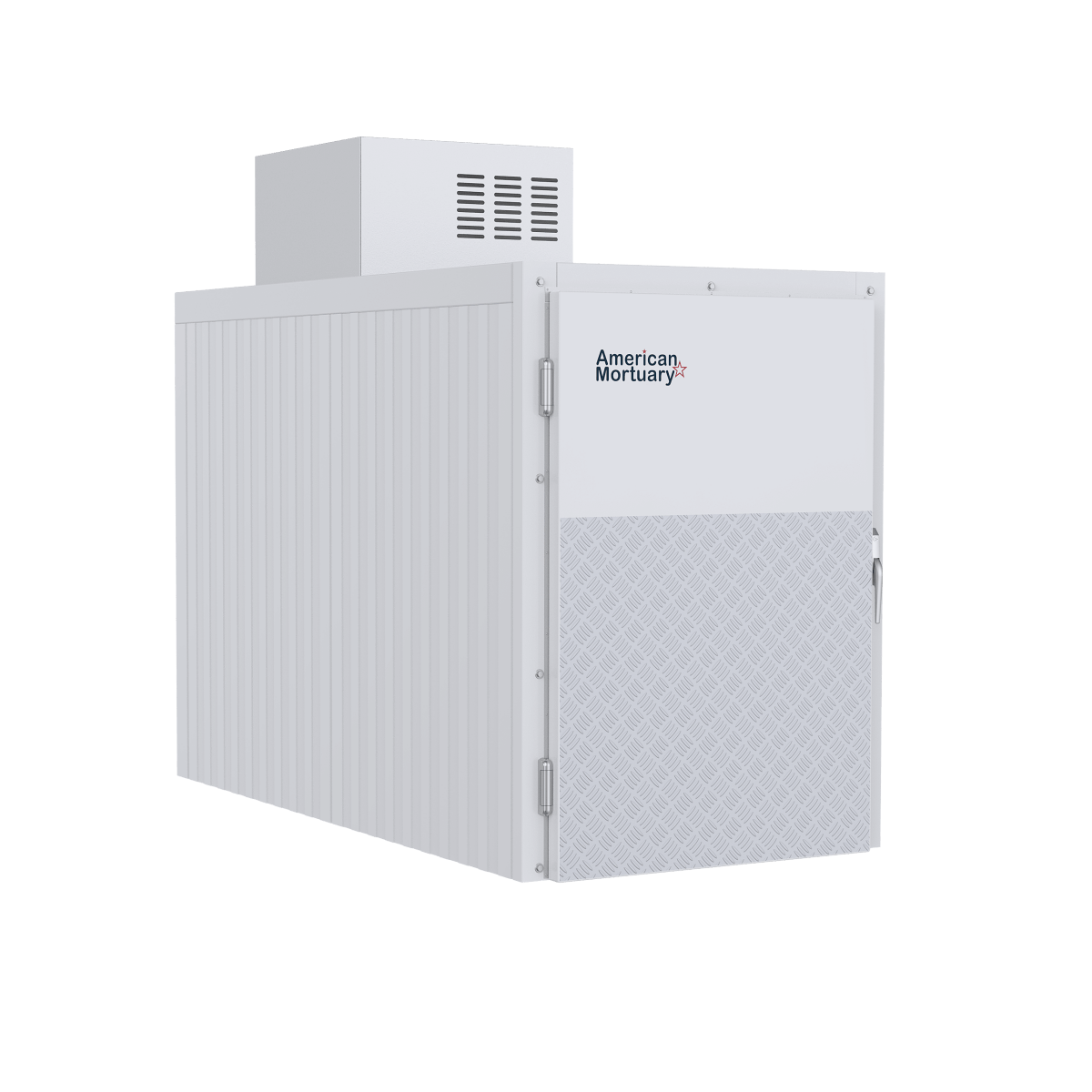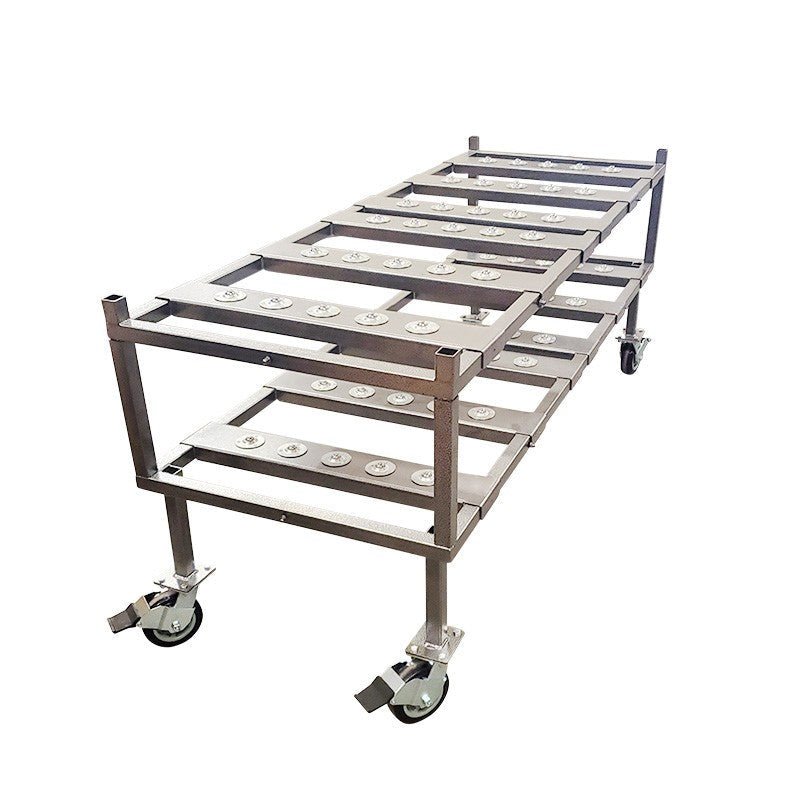The Critical Role of Morgue Cold Storage
Morgue cold storage refers to specialized refrigeration systems designed to preserve human remains at controlled temperatures, typically between 2°C and 5°C (36°F to 41°F). These systems are essential for funeral homes, hospitals, and forensic facilities to maintain dignity and delay decomposition.
| Key Aspects of Morgue Cold Storage | Details |
|---|---|
| Primary Purpose | Slow decomposition process to allow time for funeral arrangements, viewings, and investigations |
| Temperature Range | 2°C to 5°C (36°F to 41°F) for standard refrigeration; -10°C to -50°C (14°F to -58°F) for freezers |
| Common Types | Walk-in coolers, body boxes, refrigerated cabinets, mobile/pop-up units |
| Typical Capacity | From 1-6 bodies (body boxes) to 5-50 bodies (walk-in units) |
| Preservation Period | 4-6 weeks in standard refrigeration; months to years in freezers |
Proper cold storage facilities are not just practical necessities—they're essential for maintaining the dignity of the deceased while providing families the time needed for funeral arrangements. The right system balances temperature control, capacity needs, and operational efficiency.
In forensic settings, these systems preserve evidence integrity. For religious and cultural practices, they accommodate extended viewing periods or delayed ceremonies. For funeral directors, they're a cornerstone of providing compassionate, professional service.
Key benefits include:
- Slowing bacterial growth and enzymatic processes that cause decomposition
- Providing dignified, respectful storage without chemical preservation
- Supporting forensic investigations with minimal evidence compromise
- Enabling extended viewing periods for families
- Meeting regulatory requirements for human remains handling
I'm Mortuary Cooler, a national supplier of mortuary refrigeration systems with extensive experience designing and implementing morgue cold storage solutions across the United States. My expertise spans from small funeral home installations to large-scale hospital and forensic facility projects.

Quick morgue cold storage definitions:
Understanding Morgue Cold Storage Basics
When we talk about morgue cold storage, we're discussing much more than just refrigeration equipment. We're talking about systems designed to preserve the dignity of those who have passed while giving families the time they need during difficult moments.
At its core, morgue cold storage works by slowing the natural processes that begin immediately after death. Our bodies contain bacteria and enzymes that continue their activity after we pass. By maintaining temperatures between 2°C and 5°C, we dramatically slow these processes, creating a respectful window for families to make arrangements and say goodbye.
I've spoken with many funeral directors over the years who share stories about how proper cold storage has helped families during their most difficult days. As Sarah, a director in Memphis, told me, "Having reliable cold storage means I never have to rush a family through their grief. That extra time is priceless."
Different facilities naturally have different requirements. Funeral homes need dependable systems for bodies awaiting preparation and viewing. Hospitals require interim storage until transfer to funeral homes. Forensic labs need specialized systems that preserve evidence integrity. And in disaster scenarios, portable solutions become essential for respectful handling in challenging circumstances.
Why Every Facility Needs Morgue Cold Storage
The necessity for proper morgue cold storage goes well beyond practical considerations—it's deeply intertwined with legal requirements, ethical standards, and cultural respect.
From a regulatory standpoint, most states and municipalities have strict guidelines. Many require bodies to be embalmed or refrigerated if final disposition won't occur within 24-48 hours. Larger communities typically mandate that funeral facilities maintain adequate refrigeration capacity based on population served.
Cultural and religious needs also make proper storage essential. Some traditions require specific time periods between death and funeral services, with particular preparation rituals. I remember installing a system for a funeral home in a diverse Chicago neighborhood whose director explained, "Our families come from dozens of cultural backgrounds, each with their own traditions for honoring their loved ones. Our cold storage system gives us the flexibility to respect every family's needs."
For medical examiners and coroners, proper storage ensures they can conduct thorough investigations without time pressure, maintaining evidence integrity throughout the process.
Positive vs. Negative Temperature Chambers
When selecting the right morgue cold storage solution, understanding the difference between positive and negative temperature systems is crucial.
Positive temperature chambers maintain temperatures between 2°C and 5°C, effectively slowing decomposition while keeping the body in a condition suitable for viewing, embalming, and funeral services. These systems are the workhorses of most funeral homes and hospital morgues.
I remember installing a positive temperature walk-in cooler for a family-owned funeral home in Nashville. The owner later told me, "This system gives families the gift of time—up to four weeks to gather distant relatives or make complex arrangements without feeling rushed during their grief."
Negative temperature chambers operate at much colder temperatures, usually between -10°C and -50°C, essentially freezing the remains and halting decomposition almost completely. These specialized freezers serve specific purposes in forensic work, research facilities, and situations requiring extended preservation.
| Feature | Positive Temperature (2-5°C) | Negative Temperature (-10°C to -50°C) |
|---|---|---|
| Decomposition rate | Slowed significantly | Nearly halted |
| Typical use case | Funeral homes, hospitals | Forensic labs, research facilities |
| Preservation period | 4-6 weeks | Months to years |
| Tissue integrity | Maintained for viewing | Frozen, not ideal for immediate viewing |
| Energy consumption | Lower | Higher |
| Cost | More affordable | More expensive |
| Defrost requirements | Minimal | Regular defrost cycles needed |
The science behind these systems is fascinating but straightforward. In positive temperature systems, we're slowing bacterial growth and enzymatic processes without freezing tissues. In negative systems, we're essentially pausing these processes by freezing the remains.
Your choice between these options should reflect your facility's specific needs, the communities you serve, and the services you provide. At American Mortuary Coolers, we help guide clients through these decisions with compassion and expertise, ensuring you select the system that best serves your unique situation.
Main Types of Morgue Cold Storage Systems
When it comes to morgue cold storage, there's no one-size-fits-all solution. At American Mortuary Coolers, we've helped countless funeral homes, hospitals, and forensic facilities find the perfect system for their unique needs. Whether you're handling a few cases weekly or serving a major metropolitan area, we have options that balance capacity, space constraints, and budget considerations.

Walk-In Coolers & Freezers
Walk-in systems are the workhorses of the industry. I remember installing one for a funeral home in Memphis that transformed their entire operation. The funeral director called me six months later to say, "I don't know how we managed before this."
These modular units can accommodate anywhere from 5 to 50 bodies, making them perfect for busy facilities. The beauty of walk-ins lies in their flexibility – we build them using prefabricated panels that can be assembled in almost any space and expanded later if your needs grow.
Most of our customers love the side-loading rack systems we install. They maximize capacity while keeping everything organized and accessible. One medical examiner in Nashville told me, "The side-loading racks doubled our capacity without expanding our building footprint. Best investment we've made in years."
Our walk-in units feature 4-inch thick insulated panels that maintain stable temperatures while keeping energy costs manageable. For our Southern customers dealing with scorching summers, we recommend improved insulation and redundant cooling systems – a small investment that pays dividends during those August heat waves.
Want to dive deeper into specifications? Check out more info about walk-in specs.
Body Boxes & Refrigerated Cabinets
Not every facility needs a walk-in cooler. For smaller operations or those needing backup capacity, our body boxes and refrigerated cabinets are perfect solutions. These standalone units typically hold 1-6 bodies and fit neatly into existing spaces.
A funeral director in rural Kentucky recently told me, "Our 3-body refrigerated cabinet was exactly what we needed. It fits perfectly in our preparation room and handles our typical caseload with room to spare."
These units shine in their attention to detail. We craft them with 304 stainless steel interiors and heliarc-welded seams that prevent leaks and make cleaning a breeze. The digital temperature controls and alarm systems provide peace of mind, especially during weekends when facilities might be unattended.
Safety is paramount in everything we build. That's why our refrigerated cabinets include features like magnetic door gaskets, OSHA-compliant safety release handles, and heated door frames that prevent condensation – small details that make a big difference in daily operations.
Mobile & Pop-Up Morgue Cold Storage
Sometimes you need morgue cold storage that can go where you go or expand quickly during emergencies. Our mobile and pop-up solutions answer this call with impressive flexibility.

Our refrigerated trailers and shipping container systems have become increasingly popular for disaster response and temporary capacity expansion. After a tornado hit a small town in the Midwest, we delivered a 20-foot container unit that was operational within hours of arrival. The emergency management director later said, "That container system was a lifesaver during an impossible situation."
For even faster deployment, our AirCool Pop-Up Systems create instant cold rooms that can be set up in minutes. They come in various capacities – from 4 to 24 bodies – and work even in challenging environments with external temperatures up to 40°C.
Many forward-thinking facilities keep mobile units as part of their emergency preparedness plans. A hospital administrator in Florida explained their approach: "After what we experienced during hurricane season two years ago, having a deployable morgue solution ready to go gives us tremendous peace of mind."
From walk-in coolers that serve as the backbone of busy operations to pop-up units that deploy at a moment's notice, the right morgue cold storage system makes all the difference in providing dignified care while meeting practical needs. At American Mortuary Coolers, we're proud to offer solutions that help professionals across the country handle life's most difficult moments with compassion and efficiency.
Temperature Science, Energy Efficiency & Decomposition Control
Ever wonder what makes a morgue cold storage system work so well? It's all about the delicate dance of thermodynamics – creating that perfect environment that slows biological processes without freezing up your energy bill.
When we design cooling systems at American Mortuary Coolers, we're tackling several challenges at once. Think about it: heat constantly tries to sneak in through walls and ceilings, staff members open doors throughout the day, outdoor temperatures swing wildly, and interior lighting adds its own heat. It's a complex puzzle!
Our insulated panels are the unsung heroes here, limiting heat gain to just about 8 W/m². That might not sound impressive until you realize how dramatically it reduces the workload on your cooling system. It's like putting a really good winter coat on your cooler.
The heart of any system is its compressor technology. Our units feature high-efficiency compressors with smart low-ambient controls that adjust their performance based on actual cooling needs. When demand drops, so does your energy consumption – a win for both your facility and your utility bills.
For smaller facilities or those looking for backup options, we often recommend CoolBot technology. As one funeral director from the Pacific Region told us: "Our CoolBot-equipped 8'x8' cooler keeps a rock-solid 37-38°F using just a standard 12,000 BTU air conditioner, and costs pennies compared to traditional systems." It's a clever solution that transforms ordinary air conditioners into effective cooling units for smaller applications.
How Morgue Cold Storage Slows Decomposition
Understanding the science behind decomposition helps us appreciate why proper morgue cold storage is so crucial for maintaining dignity in death care.
After death, two relentless processes begin immediately:
First, the body's natural bacteria – helpful during life – begin consuming tissues. At room temperature, they multiply at an alarming rate. Second, the body's own enzymes start breaking down cells in a process called autolysis – essentially, self-digestion.
By keeping temperatures between 2°C and 5°C (36°F to 41°F), our morgue cold storage systems put the brakes on both processes. Bacteria reproduce about 10 times slower at these temperatures, enzymatic activity drops by 40-60%, odors remain minimal, and tissues maintain their integrity for viewing and examination.
"Every single degree matters," explains a pathologist who uses our systems in the Northeast. "A properly maintained 4°C environment can extend viable preservation by weeks compared to environments with fluctuating or higher temperatures."
For situations requiring longer-term preservation, negative temperature chambers (-10°C to -50°C) essentially press pause on decomposition by freezing tissues. While this virtually stops bacterial growth and enzymatic activity, it does create different challenges – like potential tissue damage during thawing – making freezers less ideal for bodies that will be viewed.
Generally speaking, bodies remain in viewable condition for 4-6 weeks at standard refrigeration temperatures (2-5°C), while freezing can preserve remains for months or even years. Of course, individual factors like the person's condition before death, cause of death, and how quickly refrigeration began all play important roles in preservation quality.
For more detailed information on temperature management, check out The Complete Guide to the Temperature of Morgue Coolers.
Energy-Saving Features Inside Morgue Cold Storage
At American Mortuary Coolers, we believe efficiency and respect go hand in hand. That's why we've built sustainability into every aspect of our morgue cold storage systems.

Our high-performance insulation is the foundation of energy efficiency. We use 60-80mm thick polyurethane panels with exceptional R-values that create a thermal fortress. Vapor barriers prevent moisture from sneaking in, while seamless construction eliminates those pesky thermal bridges where cold air escapes. This careful design limits heat gain to just 8 W/m² – a significant achievement in thermal efficiency.
The refrigeration technology itself is equally impressive. Digital temperature controllers maintain precise conditions while low-ambient controls adjust compressor function based on actual demand – like cruise control for your cooler. Defrost timers are optimized to use minimal energy, and we carefully select refrigerants that balance environmental impact with cooling efficiency.
Even the little things matter. Our LED vapor-proof lighting uses 75% less energy than fluorescent alternatives while lasting much longer. In walk-in units, motion sensors ensure lights only operate when needed. Door closers and magnetic gaskets create tight seals that keep the cold in and the heat out, while alarm systems alert staff to doors left ajar.
A Chicago funeral home recently shared that they cut their energy costs by 32% after upgrading to our energy-efficient walk-in system with improved insulation and LED lighting. That's money back in their pocket while still providing excellent care.
For those inevitable power outage situations, we recommend redundant refrigeration systems that can operate independently, battery backups for critical control systems and alarms, automatic generator connections for quick power restoration, and temperature monitoring systems that send remote alerts if conditions change.
These features don't just reduce your monthly bills – they improve reliability, which is absolutely critical when you're entrusted with preserving human remains with dignity and respect.
Selecting & Configuring the Right Morgue Cold Storage

Finding that perfect morgue cold storage solution is a bit like finding the right home—it needs to fit your needs today while accommodating tomorrow's growth. At American Mortuary Coolers, we walk alongside our clients through this important decision, ensuring they end up with a system that feels custom-made for their unique situation.
Start by having an honest conversation about capacity. How many bodies do you typically need to store? I remember visiting a funeral home in Memphis that consistently underestimated their needs until a particularly difficult winter pushed them beyond capacity. Consider your average case volume, but also think about those peak periods when demand surges. And don't forget to look ahead—how might your business grow over the next decade?
Your facility itself will guide many decisions. I once worked with a historic funeral home in Boston whose narrow doorways and tight corners eliminated several options immediately. We'll need to consider your available space, access routes for dignified transport, and whether your floors can support the weight of a fully-loaded system. Electrical capacity matters too—I've seen too many funeral directors find too late that their building's wiring needs upgrading to support new refrigeration.
The way you and your staff move and handle bodies makes a tremendous difference in daily operations. Side-loading racks typically allow more efficient use of space than end-loading designs, while roll-out trays reduce staff strain compared to fixed shelving. If you serve communities with higher obesity rates, bariatric accommodation becomes essential—something a funeral director in Oklahoma learned the hard way before upgrading to our reinforced tray system.
When talking budget, look beyond the price tag. A funeral director in Virginia told me: "I initially balked at American Mortuary Coolers' quote being 15% higher than a competitor, but five years later, I've saved that difference twice over in reduced energy costs and zero repair bills." Consider the initial investment alongside operating costs, expected lifespan, and future expansion potential.
"Don't just buy for today's needs," advised one of our long-time customers in Florida. "We purchased a walk-in system from American Mortuary Coolers with 30% more capacity than we initially required, and within three years, we were regularly using that extra space."
Customization Factors That Impact Operations
The small details of your morgue cold storage system can dramatically impact your daily workflow. These customization choices often get overlooked during planning but can make the difference between a system that fights against you and one that feels like an extension of your team.
Shelving and body handling systems deserve careful consideration. Cantilever shelving allows you to adjust heights as needed—particularly helpful when dealing with varied tray sizes. One medical examiner I worked with in Seattle switched to our roller systems and immediately noticed staff members no longer complained about back strain after transfers. Smart identification systems prevent mix-ups in multi-body storage—something that brings peace of mind to everyone involved.
Lifting and transfer equipment might seem like an optional add-on, but they're investment in your staff's wellbeing. A medical examiner's office in Boston reported a 40% reduction in staff back injuries after installing our integrated lift system. Whether you choose manual or powered cadaver lifts, look for adjustable height mechanisms that accommodate different staff members and reversible fork designs that work with various tray styles.
The most beautiful cooler becomes problematic quickly without proper hygiene features. Floor drains might not seem exciting until you're trying to sanitize a unit without them. Seamless interior surfaces eliminate those hard-to-clean crevices where bacteria hide, while antimicrobial finishes provide an extra layer of protection.
"The floor drain and washable interior of our American Mortuary Coolers unit transformed our cleaning process," a Dallas funeral director recently told me. "What used to take hours now takes minutes, and the sanitation level is far superior."
Environmental controls extend beyond basic temperature. Humidity management prevents that unwelcome condensation that can create slip hazards and damage finishes. Air exchange systems minimize odors—something families will silently appreciate. And temperature monitoring with remote alerts means you'll know about problems before they become emergencies, even when you're not on-site.
Temporary vs. Permanent Morgue Cold Storage Solutions
Sometimes life throws curveballs that make you question whether to invest in permanent morgue cold storage or opt for temporary solutions. Both approaches have their place, and many of our clients find value in understanding when each makes sense.
Permanent solutions like walk-in coolers, built-in refrigerated cabinets, and custom-designed morgue suites offer stability and reliability. They become part of your facility's infrastructure, offering lower long-term operational costs once the initial investment is absorbed. The temperature stability tends to be superior, and many funeral directors appreciate the professional appearance when families visit. Plus, security and access control are typically more robust.
On the flip side, temporary solutions provide flexibility that permanent installations simply can't match. Rental refrigerated trailers, portable cooling systems, pop-up cold rooms, and containerized units can be deployed quickly during emergencies or busy seasons. They require no long-term capital commitment and can be relocated as needs change.
Many facilities find wisdom in the middle path. A hospital in Pittsburgh maintains a permanent walk-in cooler for everyday needs while keeping contracts in place for emergency mobile units. When an unfortunate bus accident overwhelmed their capacity last year, they had additional refrigeration on-site within hours.
The rental market has grown significantly more sophisticated in recent years. At American Mortuary Coolers, we offer everything from weekly rentals to extended leases with maintenance included—helping facilities manage cash flow while ensuring access to quality equipment.
For those involved in emergency management, I strongly recommend establishing relationships with mobile solution providers before disasters strike. An emergency management director in the Midwest told me: "Having pre-approved contracts and delivery protocols in place saved precious hours when we needed additional capacity following a transportation accident. Those hours mattered deeply to the affected families."
A Comprehensive Guide to Mortuary Cold Storage Options
Regulatory & Hygiene Requirements for Morgue Cold Storage
Navigating the regulatory landscape for morgue cold storage can feel overwhelming, but these standards exist for good reason—ensuring safety, dignity, and proper care. Understanding these requirements helps you select a system that won't cause compliance headaches down the road.
OSHA requirements focus primarily on safety features. Those interior safety release handles might seem like a small detail until someone accidentally gets locked inside a cooler (yes, it happens more than you'd think). Proper lighting prevents accidents during transfers, while non-slip flooring becomes essential when dealing with occasional fluid spills. Clear labeling of hazards and instructions isn't just regulatory compliance—it's about protecting your team.
Health departments typically focus on temperature monitoring, proper ventilation, and waste management systems. They want assurance that temperatures remain stable and documentation proves it. A funeral director in New York shared: "Our health department inspection was seamless because our American Mortuary Coolers unit came with built-in temperature logging that exceeded regulatory requirements."
Construction standards ensure your equipment meets established safety codes. NSF-certified materials (similar to food-grade requirements), UL-listed electrical components, and compliance with local building codes aren't just regulatory checkboxes—they're your assurance of quality and safety. Energy efficiency standards like EISA also help control your operational costs.
Hygiene protocols matter deeply in this industry. Surface materials make a tremendous difference—304 stainless steel with heliarc-welded seams eliminates places where contamination can hide. Seamless fiberglass works wonderfully in high-contamination areas, while antimicrobial coatings on frequently touched surfaces provide additional protection. Those coved corners that eliminate sharp edges aren't just about cleaning ease—they're about infection control.
Cleaning procedures should be systematic and thorough. Regular disinfection with hospital-grade cleaners, documented cleaning schedules, and staff training on proper techniques protect everyone involved. Removable components allow for deeper cleaning of otherwise inaccessible areas.
Contamination prevention extends to body fluid containment systems, proper drainage with backflow prevention, and separate ventilation systems. Having personal protective equipment stations nearby encourages staff to use appropriate protection consistently.
At American Mortuary Coolers, we provide comprehensive documentation packages with all our systems, including cleaning protocols, temperature logs, and maintenance schedules. These resources help ensure you stay compliant while providing dignified care—because regulatory compliance and respect for the deceased go hand in hand.
Innovations & Trends Shaping Morgue Cold Storage
The world of morgue cold storage is constantly evolving, with exciting new technologies making these essential systems more effective and user-friendly. At American Mortuary Coolers, we're passionate about staying ahead of these innovations so we can provide you with the most advanced solutions for your facility.

Remember when checking the temperature of your cooler meant physically walking to the unit and looking at a gauge? Those days are thankfully behind us. Today's morgue cold storage systems feature smart monitoring that connects to the internet, giving you peace of mind from anywhere.
"The WiFi alerts from our American Mortuary Coolers system have been a genuine lifesaver," shares Maria, a facility manager from Los Angeles. "Just last month, I received a 2 AM alert about rising temperatures caused by a power fluctuation. I was able to address it immediately, preventing what could have been a serious situation."
These smart systems don't just send alerts—they maintain 30-day temperature histories you can access right from your smartphone, and they can even monitor if doors are accidentally left open. It's like having a dedicated staff member watching your cooler 24/7.
Another exciting development is the rise of dual-zone chambers. Rather than needing separate units, newer systems often include both positive temperature areas (2-5°C) for short-term storage and negative temperature sections (-10°C to -20°C) when longer preservation is needed. This flexibility is particularly valuable for facilities with varying needs or limited space.
The environment is on everyone's mind these days, and morgue cold storage manufacturers are responding with eco-friendly refrigeration technologies. We're seeing a shift toward refrigerants with lower global warming potential, more energy-efficient compressors that reduce both your carbon footprint and electric bill, and even solar power integration for remote locations or emergency deployments.
Perhaps surprisingly, aesthetics have become increasingly important in the industry. Modern facilities recognize that the appearance of cooler exteriors matters, especially in spaces where families might be present. Custom color-matched exteriors that blend seamlessly with your facility's décor, wood-grain or stone-look finishes, and tasteful recessed lighting all contribute to creating a more respectful atmosphere during difficult times.
Future of Morgue Cold Storage Technology
Looking ahead, the future of morgue cold storage promises even more impressive innovations that will transform how we preserve and care for the deceased.
Artificial intelligence is beginning to revolutionize temperature management in remarkable ways. Imagine a system that can predict when maintenance will be needed before any problems occur, or one that learns your facility's usage patterns and adjusts cooling cycles accordingly to save energy. These AI-powered analytics aren't science fiction—they're already appearing in premium systems and will become standard features before long.
For forensic applications, specialized rapid-freeze technology is developing at an impressive pace. Flash-freezing capabilities can preserve evidence in optimal condition, while targeted cooling systems focus on specific body regions when needed. Some advanced units even include non-invasive temperature monitoring of internal tissues and integrated imaging systems for documentation during the preservation process.
"Innovation is important," notes James, one of our engineers at American Mortuary Coolers, "but in this industry, reliability can never be compromised for novelty. We evaluate every new technology through this lens."
Perhaps the most exciting development for emergency response is the evolution of modular container laboratories. These self-contained units combine storage with functional workspace, essentially creating deployable forensic labs with integrated refrigeration. Some advanced models include telemedicine capabilities that connect remote pathologists to the field, and many feature off-grid capabilities for disaster response in areas where infrastructure has been compromised.
Extended Viewing, Cultural Needs & Forensic Advancements in Morgue Cold Storage
Modern morgue cold storage systems do far more than simply preserve remains—they help honor diverse cultural practices, support extended family needs, and improve forensic investigations.
Different faith traditions have specific requirements that quality storage systems must accommodate. Some Jewish and Muslim traditions call for burial within 24 hours, but may require extensions when family members need to travel. Hindu traditions often involve family-performed preparation rituals. Various cultural practices require specific body positioning or items to remain with the deceased.
"Our American Mortuary Coolers walk-in system has been a blessing for our diverse community," explains Robert, a funeral director in Chicago. "We serve families from dozens of cultural backgrounds, and our flexible system allows us to honor their specific traditions while maintaining proper preservation."
Today's families often need more time before services than previous generations. With relatives scattered across the country or even internationally, coordinating gatherings takes longer. Many families prefer extended memorial planning periods, while the growing green burial movement requires preservation without embalming. Our positive-temperature systems maintain bodies in viewable condition for 4-6 weeks, giving families the precious gift of time during difficult decisions.
In forensic settings, morgue cold storage plays a crucial role in maintaining evidence integrity. Negative temperature chambers preserve evidence for extended periods, while specialized storage compartments keep separated tissues and samples in optimal condition. Integrated documentation systems track chain of custody, and temperature logging validates preservation conditions for court testimony.
Dr. Martinez, a forensic pathologist in Arizona, notes: "The dual-temperature system from American Mortuary Coolers has transformed our evidence handling. We can maintain different types of evidence at their optimal temperatures, ensuring our findings stand up to the most rigorous legal scrutiny."
Organ donation programs also benefit from specialized cooling systems that support their critical timing needs. Rapid cooling systems preserve organ viability, while precise temperature control extends donation windows. Mobile cooling units facilitate transport to recipient facilities, and robust documentation systems ensure protocol compliance.
From honoring ancient traditions to supporting cutting-edge medical science, today's morgue cold storage systems are more versatile and capable than ever before—and at American Mortuary Coolers, we're proud to be leading this evolution.
Frequently Asked Questions About Morgue Cold Storage
How long can a body be safely stored in morgue cold storage?
One of the most common questions we hear from funeral directors and facility managers relates to preservation timeframes. The truth is, it varies based on several factors.
In standard morgue cold storage (2-5°C or 36-41°F), most bodies can be preserved in viewable condition for 4-6 weeks. After this window, you'll start to notice progressive changes that make viewing less appropriate. This timeline shortens if the deceased wasn't refrigerated promptly after death.
I remember speaking with James, a funeral director in Johnson City who told me: "With our American Mortuary Coolers system keeping steady at 38°F, we've successfully preserved bodies for five full weeks when families needed extra time. Getting the deceased into refrigeration quickly makes all the difference."
For forensic applications requiring longer-term preservation, negative temperature storage (-10°C to -50°F) can extend preservation for months or even years. However, freezing causes cellular damage that affects appearance after thawing, making these systems less suitable for viewing purposes.
Several factors influence how long preservation remains effective:
- The interval between death and refrigeration
- Underlying cause of death and initial condition
- Pre-existing medical conditions
- Body mass and composition
- How stable the storage temperature remains
For best results, we always recommend prompt refrigeration, minimal temperature fluctuations, and careful positioning to prevent pressure points that can cause discoloration.
What are typical running costs and how can they be reduced?
Understanding the ongoing expenses of morgue cold storage helps with budgeting and identifying cost-saving opportunities. Let's break down what you can expect.
Energy consumption typically forms the largest ongoing expense. Walk-in coolers generally run between $150-$400 monthly depending on size and usage patterns, while smaller body boxes (2-4 capacity) might cost $50-$120 per month. These figures vary significantly by region – our Northeast customers typically pay 30-40% more than those in the Southeast due to regional energy rate differences.
Regular maintenance adds another layer of expense: preventative maintenance averaging $800-$1,500 annually, refrigerant services at $200-$400 per visit, and quarterly filter replacements running $100-$200.
Then there's the occasional repair costs. A compressor replacement might set you back $1,500-$3,000, evaporator fan motors typically cost $300-$500, and door gaskets and hardware replacements range from $200-$600.
Sarah, a funeral home manager in Atlanta, shared this with us recently: "After upgrading to American Mortuary Coolers' energy-efficient walk-in with better insulation, our monthly electricity bill dropped by nearly $200. It's paying for itself faster than we expected."
You can reduce these ongoing costs through several approaches. Improved insulation can cut energy costs by 15-25%. LED lighting reduces electricity use by up to 75% compared to older options. Digital temperature controls with optimization algorithms prevent wasteful cooling cycles. Even simple steps like cleaning condenser coils quarterly can improve efficiency by up to 15%.
Operational practices matter too. Consider consolidating bodies during low-volume periods, training staff on proper door usage to minimize open time, and implementing motion-activated lighting to reduce unnecessary illumination.
We're always happy to perform energy assessments for our customers to identify specific savings opportunities for your facility.
Can mobile morgue cold storage meet the same regulatory standards as permanent units?
Absolutely! Modern mobile morgue cold storage solutions can meet—and sometimes even exceed—the same regulatory standards as permanent installations. But achieving compliance depends on proper selection, setup, and operation.
Today's quality mobile units maintain the same temperature ranges (2-5°C for refrigeration, -10°C to -20°C for freezing) as permanent installations. Many actually feature improved cooling capacity to handle the more frequent door openings typical in emergency or field conditions.
Construction standards haven't been compromised either. Reputable manufacturers use NSF-certified materials, incorporate OSHA-compliant safety features like interior release mechanisms, and include UL-listed electrical components. Proper ventilation and air exchange systems come standard in quality units.
Documentation capabilities have advanced tremendously in recent years. The mobile units we provide at American Mortuary Coolers include digital temperature monitoring and logging, alarm systems with remote notifications, and comprehensive documentation systems that satisfy regulatory requirements.
Mark, an emergency management director who used our container systems following a hurricane, told us: "The mobile units arrived with complete documentation packages and monitoring systems that immediately satisfied all health department requirements. We were operational within hours of delivery."
Successfully deploying mobile units does require attention to certain details. You'll need reliable power supply, protection from extreme weather, appropriate security measures, level surfaces for placement, and proper waste management systems.
If you're considering a mobile solution, we recommend these practical steps:
- Consult with your local regulatory authorities before deployment
- Choose units specifically designed for mortuary use (not repurposed food refrigeration)
- Implement clear procedures for documentation
- Train your staff thoroughly on proper operation
- Establish regular inspection schedules
With proper implementation, mobile morgue cold storage provides flexible, fully compliant solutions whether you're responding to emergencies, temporarily expanding capacity, or serving remote locations.
Conclusion
Choosing the right morgue cold storage system isn't just a practical decision—it's an investment in dignity, respect, and professional service. Throughout this guide, we've explored the science, options, and considerations that go into creating the perfect preservation environment for those in your care.
At American Mortuary Coolers, we've walked alongside countless funeral homes, hospitals, and forensic facilities as they've steerd these important decisions. From our Tennessee workshop to installations across all 48 contiguous states, we've seen how the right equipment transforms operations and improves service quality.
When you're ready to select your morgue cold storage solution, keep these essential factors in mind:
Start with thoughtful capacity planning. Look beyond today's needs to tomorrow's growth. Many of our clients find that adding 20-30% more capacity than currently needed proves wise within just a few years.
Consider temperature requirements carefully. While standard refrigeration (2-5°C) works beautifully for most funeral homes, your specific needs might call for freezer capabilities (-10°C to -50°C) for longer preservation or forensic work.
Work within your space reality. Whether you're blessed with abundant room or navigating tight quarters, today's modular designs can maximize every square foot. One funeral director told us, "I didn't think we had room for a walk-in until your team showed us a custom layout that fit perfectly in our existing space."
Factor energy efficiency into your budget calculations. The lowest upfront cost rarely translates to the best long-term value. Modern insulation and compressor technologies often pay for themselves within 3-5 years through reduced utility bills.
Personalize your system with thoughtful customization. From specialized bariatric trays to ergonomic loading systems, these details make daily operations smoother and safer for your team.
Ensure complete regulatory compliance from day one. Our systems include documentation packages and monitoring tools that satisfy health department requirements and simplify inspections.
Plan for the unexpected with backup power options and potential surge capacity solutions. As one medical examiner told us, "Having a contingency plan isn't just good business—it's essential for community service."
Whether you're building from scratch, renovating an existing facility, or preparing for emergency response, the perfect morgue cold storage solution provides peace of mind through reliable performance and dignified preservation.
We understand that behind every technical specification and feature is a commitment to serving families during their most vulnerable moments. That's why we approach each project not just as equipment suppliers, but as partners in your mission of care and respect.
When you're ready to explore options for your facility, our team is here to guide you through each step with the same care and attention to detail we put into crafting our cooling systems.
More info about premier walk-in body refrigerators
canada stretchers and cots market


